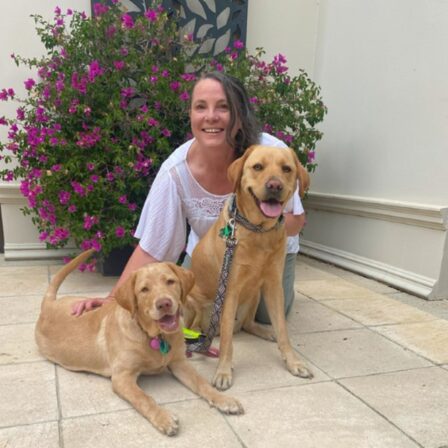News
Guide Dogs Victoria celebrates International White Cane Day 2024
On International White Cane Day (IWCD), we recognise the achievements of people with low vision or blindness who choose to use a white cane and the importance of the white cane as a tool for people in the low vision and blind community. IWCD is always a significant day on the Guide Dogs calendar, as the white cane is the mobility tool of choice for most of our Clients.
The white cane is more than just a mobility aid – it symbolises independence, freedom and community connection. At Guide Dogs Victoria we provide personalised training to help our Clients master white cane mobility, empowering individuals to unlock new opportunities and navigate their world with confidence.
Celebrated on 15 October each year since 1964, this year we honoured IWCD with a dedicated event at our newly completed fully accessible, sensory Campus. Guide Dogs Victoria (GDV) Clients and staff were invited to a guided tour of our sensory garden, which is filled with different textures, scents, and sounds for a fully immersive sensory experience.
After the tour, the celebrations moved to the Community Hub for a delicious morning tea and an Assistive Technology Expo where three providers of assistive tech showcased their innovative products designed to enhance the lives of people with low vision or blindness. Clients enjoyed the opportunity to explore their products and the ways they can impact their daily life. Bringing together Clients, staff and external partners that work hard to empower the low vision and blind community was the perfect way to connect and celebrate the importance of the white cane.

Image description: A group of GDV Clients walk down the gravel path in our sensory garden holding their white canes. To the left is a patch of grass with a fenced off pond in the background. Above them the sky is covered in patchy clouds with some areas of blue peeking out.

Image description: The koi pond and greenery in GDV’s sensory garden. Large rocks are in the front left and smaller rocks line the pond in the background. A fence encloses the pond which is visible in the background and meets the side of the reception building.

Image description: One of the assistive technology partners from Pacific Vision looks into the camera as he stands next to his display table featuring two computer screens on the table top. The screens are magnifying documents underneath them.
Did you know?
Although commonly called a ‘white’ cane, not all white canes are in fact white! White canes can be fully customised to an individuals’ needs. Someone may use a long cane while others may prefer an identification cane or a support cane. Some canes fold while others are rigid. They can be made of aluminium or other materials like graphite or fiberglass with handles made of rubber or cork. There are many different colour options to choose from and a variety of cane tips which all have different purposes. White canes are unique to each person that uses them, and some even choose to decorate their cane!
How can I help someone using a white cane?
There are many ways you can help a person who uses a white cane, and some are especially crucial to their safety.
- Be aware of surroundings and look up while walking. Try to avoid burying your face in your phone. 70 per cent of white cane users experience issues with people who are distracted while using their mobile phones.
- Clear pathways of obstructions. More than 90 per cent of white cane users face challenges from obstacles such as overgrown plants, improperly parked vehicles, haphazardly placed e-scooters or bins left out after collection.
- Always ensure you ask if someone needs assistance first – don’t just assume they need help. Imagine how jarring it would feel if someone came out of nowhere and grabbed you and tried to guide you in a certain direction. Communication is key.
Thank you to everyone who celebrated with us and helped create such a memorable community event!
Mobility training is valuable for anyone at any age and level of vision. Guide Dogs Victoria provides both Children’s Mobility Services and Adult Mobility Services. To explore how the service can work for you and support your personal goals, complete our online referral form.










